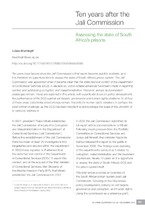| dc.description.abstract | Ten years have lapsed since the Jali Commission’s final report became publicly available, and it is therefore an opportune time to assess the state of South Africa’s prison system. The Jali Commission was appointed when it became clear that the state had lost control of the Department of Correctional Services (DCS). A decade on, some notable advances have been made in regaining control, and addressing corruption and maladministration. However, serious and persistent challenges remain. These are explored in this article, with a particular focus on policy development, the performance of the DCS against set targets, governance and human rights violations. In all four of these areas substantial shortcomings remain. Impunity for human rights violations is perhaps the most critical challenge, as the DCS has been reluctant to acknowledge the scale of this problem or to seriously address it. | en_US |

